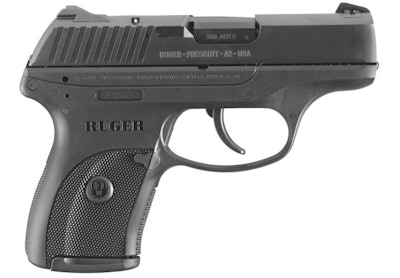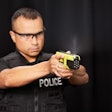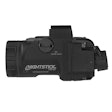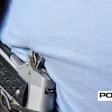 Photo by Paul Budde.
Photo by Paul Budde.
In 1912, Fabrique Nationale (FN) of Belgium introduced the John Moses Browning-designed Model 1910 chambered for a new cartridge, the 9mm Browning Short. Not to be left behind by European competition, Colt offered a Model 1908 pistol in the same caliber, rechristening the round the .380 ACP (Automatic Colt Pistol).
The original .380 ACP consisted of a straight-walled, rimless case 17 millimeters long topped with FMJ bullets weighing 85 to 95 grains. Muzzle velocity on these early .380s was approximately 900 feet per second.
Over the years the .380 ACP has been known by various monikers, including 9mm Kurz, 9mm Corto, and 9x17. While on the Continent the .380 was considered suitable for military and police service, in the U.S. it has generally been regarded as a low-end choice for self-defense. While the .380 is a better performer than the .32 ACP—and usually chambered in pistols of the same size—until recently it never achieved the same level of popularity as its smaller caliber cousin.
Three trends have caused a dramatic increase of interest in .380 pistols: materials, ballistics, and concealed carry.
- Materials—Quality .380 pistols used to be made of 100% steel and were quite heavy for their intended role. Now the use of polymer frames in this class of pistols has allowed manufacturers to lighten them significantly and make them much easier to carry all day.
- Ballistics—Improved propellants and high-tech JHP bullets have enhanced the effectiveness of the .380 cartridge, making it a much more practical choice for defensive purposes without any real increase in recoil.
- Concealed Carry—More and more states have eased their concealed carry laws (CCW) and more law enforcement agencies approve or even require their officers to carry backup guns on duty and off-duty guns during their time off, so the demand for small, lightweight handguns has skyrocketed.
Concealed Carry Pistols
Several years ago Ruger entered the concealed carry pistol market with two small-frame pistols: the 9mm LC9 and the .380 LCP. While they differed in size (5.15 vs. 5 inches in length; 9.4 vs. 17.1 ounces in weight), these two handguns shared a number of features.
Both of these Ruger pistols use alloy steel slides that sit atop glass-filled nylon frames. Glass-filled nylon not only reduces weight but is as strong as and in many cases more resistant to wear, moisture, salts, oils, and solvents than metal frames.
These subcompact Rugers also both feature locked-breech designs that use double-action-only (DAO) triggers with a "single strike" trigger mechanism. This means that if you have a misfire, or are dry firing an empty pistol for practice, it is necessary to partially retract the slide to reset the spurless hammer before you can pull the trigger again.
In both of these popular subcompact Rugers, breech locking is accomplished by the barrel hood moving up into, and bearing against the front of, the ejection port. When fired, the barrel and slide move to the rear, locked together for a short distance whereupon a cam on the bottom of the barrel articulates on the frame insert, pulling the barrel down so the slide can continue to the rear, extracting and ejecting the spent cartridge case. The recoil spring, located on a full-length guide rod under the barrel, pulls the slide forward, chambering the next round. As the slide goes into battery, the barrel is cammed up, locking the two units together and the hammer is held in a partially cocked position until a complete stroke of the trigger pulls it to full cock and releases it.
Both of these Ruger concealed carry pistols also use single-column magazines: the LCP holds six rounds; LC9 holds seven. The LC9 differs from its .380 cousin in that it has an external thumb safety and slide stop levers, and the magazine can be fitted with a finger rest extension baseplate. In addition, while the LC9 has easy-to-see, three-dot sights, those on the LCP are basic at best and almost impossible to see at worst. This is one of the reasons why a Crimson Trace laser sight was such a popular option on the LCP.
Both pistols hit the market just as American police and civilians were transferring their preference in concealed carry handguns from snub-nosed revolvers to compact and subcompact pistols. And for this reason they proved extremely popular.
I have shot and carried both of these pistols extensively and, while they are reliable, sufficiently accurate, and perform as expected, they both display one downside—recoil.
Changing Caliber
I find the tiny LCP difficult to control, especially with some of the hotter .380 loads. And while the LC9 has a decent-sized grip, it is rather narrow and extended firing can be uncomfortable. I believe that I am not the only person to voice negative comments about the LCP and LC9 because the powers that be at Ruger have introduced a pistol that addresses these complaints, the LC380.
As you might have ascertained by its model designation, the LC380 is essentially the LC9 modified to fire the .380 cartridge. In fact, the LC380 is identical to the LC9 in every respect, except for the caliber and a minuscule variation in weight.
Changing the caliber required very little modification. The breech face was machined to handle the smaller cartridge, a different extractor was installed, and the recoil spring was modified. In addition, a spacer was inserted in the rear of the magazine so that it would reliably feed the shorter .380 cartridge.
Ruger sent me an early production LC380 to evaluate for POLICE. It came with a padded gun rug, finger rest magazine baseplate, a key to activate the internal security system, and a lock. I had always found the LC9 more to my liking than the LCP and looked forward to seeing if the change in caliber provided any real advantages.
My test pistol displayed good ergonomics. The sights were fast to acquire and provided an excellent sight picture, and the DAO trigger had a smooth, stage-free stroke, albeit a bit on the heavy side.
Test Firing
I tested the new LC380 for accuracy by firing a series of groups from a rest at 10 yards. Nursing the trigger along enabled me to produce a dozen very respectable targets with four different brands of ammo printing to point of aim, or close enough that it didn't make any difference. This performance was no doubt helped by the fact that recoil was soft…very soft.
During the test firing, the pistol failed three times to go into battery, which was starting to concern me. Then I realized that it needed lubrication. A few drops of oil quickly cured the problem and it ran 100% with the next 200-plus rounds fired that afternoon.
Offhand drills performed at five yards showed the LC380 to be easy to shoot and accurate. The trigger pull smoothed out some with use, and I found the manual safety easy to use and positive in operation. Earlier I had installed the finger rest magazine floor plate on the Ruger and this provided enough real estate for a full, three-finger grip, which really improved handling and recoil control.
Of the 30 rounds expended during this stage of the test firing, only two impacted outside of the target's X and 9 rings and both of those were fired with an unsupported grip. Once again I was impressed with the soft felt recoil and how quickly I could make fast, accurate follow-up shots.
As is my usual practice the LC380 served as one of my carry guns for the next two weeks. A Galco inside-the-pocket holster let me carry it in the front pocket of my cargo pants in perfect comfort and without any signature whatsoever, but positioned it so it was easily accessible and allowed a fast, smooth presentation.
Taking into consideration the differences in on-target performance between the .380 and 9mm cartridges, the LC380 provides all the positive features of the LC9 and none of the negative ones of the LCP. The differences in size and weight between the LCP and the LC380 are relatively insignificant and you get a lighter recoiling, easier shooting pistol in the bargain. While I am a big fan of the 9mm cartridge, I have to admit I found much to admire about the LC380. For off-duty, backup, or deep concealment, it is a very viable choice.
Paul Scarlata has served as an auxiliary police officer and is a frequent contributor to POLICE.
Sturm, Ruger & Co. L380 Pistol Specs:
Caliber: .380 ACP
Magazine Capacity: 7 rounds
Overall Length: 6 inches
Barrel Length: 3.12 inches
Height: 4.5 inches
Width: 0.90 inches
Weight (unloaded): 7.2 ounces
Construction: Slide, alloy steel; Frame, glass-filled nylon; Grips, glass-filled nylon
Sights: Front, white dot; Rear, dual white dots
Extra Features: Manual safety, loaded chamber indicator, internal lock, checkered grip, magazine finger rest extension, padded carrying case, lock, and owner's manual.
Price: $449

















